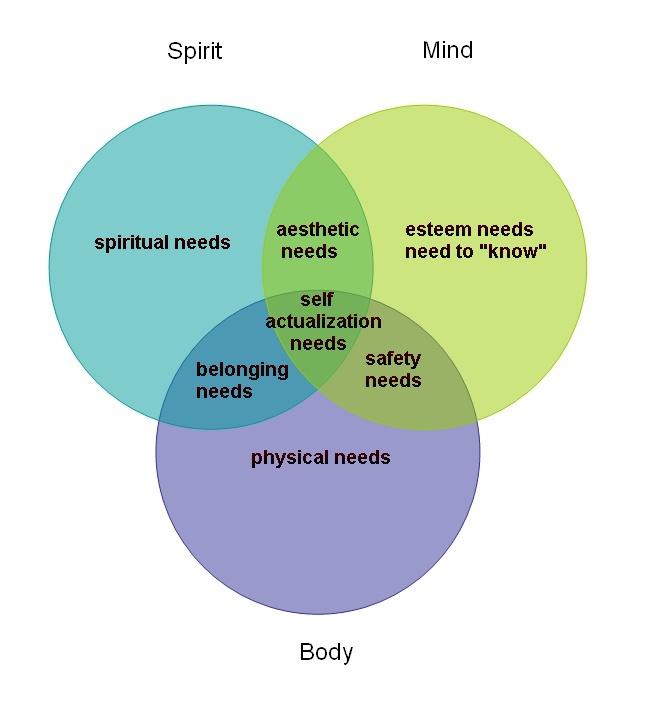Maslow's Hierarchy of Needs and the Intrapsychic Taxonomy
Maslow’s hierarchy of needs has sometimes been discussed in terms of what needs are intrinsic and what is extrinsic—Maslow discussed deficiency and growth needs—but as we try to place his hierarchy on this dichotomy, we find that some of these needs don’t fit clearly into one or the other class. Clearly, physical needs must be met through external resources, though we use agencies of mind as we work to meet those needs. Similarly, safety needs include things like shelter and clothing, and have an extrinsic basis. But safety is a psychological state as much as it is a physical reality. We are only safe if we feel safe. Basic belonging needs depend both on other people and the support one may draw from them (extrinsic), but also on the sense of being connected to something larger than ones’ self (intrinsic and spiritual). The hierarchical model, presented as a pyramid, does not adequately address these dualities.
If we superimpose Maslow’s needs onto the intrapsychic taxonomy (Figure 2), however, we find some conceptual clarity. Physical needs encompass the entire sphere of body, including those sectors of mind and of spirit influence. Esteem needs, as well as the basic need to know are located in the sphere of mind. Of course, spiritual needs, our need to understand our connectedness to something larger than ourselves, are located in the sphere of spirit. Safety needs, our need to believe we are secure in body, are located at the intersection of needs of mind and body. Belonging needs, our need to feel a connection of self to others, are located at the intersection of the needs of body and spirit. Aesthetic needs, needs to experience beauty and transcendence beyond our normal cognitive experience, not usually considered a part of the hierarchy of needs but considered by Maslow to be part of the meta-needs which are activated in self-actualizing people (Boeree, 2006a), are located at the intersection of the needs of mind and spirit.
Figure Two. Intrapsychic Taxonomy and Maslow's Hierarchy of Needs.
In this reconceptualization we might describe self-actualization as a state of integration of all of our needs and agencies, body, mind and spirit. While Maslow ascribed self actualization to two percent of the population or less, other theorists see self actualization as a drive shared by all organisms (e.g., Rogers, 1957). The intrapsychic taxonomy can accommodate both positions if one conceives of self actualizing as having both state and trait components. Thus, though we may generally not be continually self-actualizing in a Maslowian sense, we may experience moments of transcendence as we perform artistic skills or as we fully experience a religious/spiritual moment. For example, if we are caught up in the aesthetic qualities of a religious ceremony, and are reciting or singing in unison with others, then we are fully engaging all three aspects of self.
Maslow’s taxonomy of needs begins to explain violations of the predictions of the hierarchical needs structure such as we see in Mozart’s life history. Mozart was arguably the greatest composer of all time to date. His music clearly is an act of aesthetic transcendence, involving the full engagement of his higher order needs, yet Mozart produced this beautiful music while in a state of physical and safety needs deficit. Maslow’s hierarchy would predict that Mozart could not have done this.
Similarly, Americans’ responses to the terrorist attacks of September 11th, 2001 are not predicted by Maslow’s hierarchy. It was our mental selves that were attacked, as very few of us were really in any real physical danger. The zeitgeist of September 11th, 2001 was, “How could anyone hate us so much that they would sacrifice themselves in order to kill some of us?” The hierarchy of needs would predict that in response to this we would focus on our physical and safety needs. Confirming this, we watched the news, often obsessively, reassuring ourselves against physical threat. Only after governmental leaders made public statements about stopping this kind of attack from happening again (by going into Afghanistan and eradicating al Qaeda) were we able to re-enter the sphere of mind from body. But while this was predicted by the hierarchy, on September 11th, and several subsequent days, Americans also packed into their churches, seeking a sense of belonging and spiritual wholeness (hierarchically above the safety and physical needs). Only after we memorialized our fallen peers in ritual, song and folk-memorials of flowers, cards, posters and stuffed animals, set up on sidewalks near the scene of the atrocities, all aesthetic experiences, were we able to move into the sphere of mind, armed with spiritual agencies. So we did not retreat to the lower physical and safety needs only, but also sought spiritual solace and spiritual healing, something not predicted by Maslow’s hierarchy.